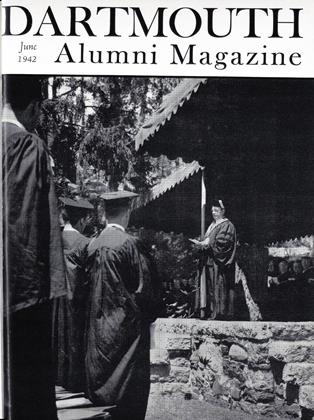byProfessor I. E. Bender, Henry A. Imus, JohnW. M. Rothney, Camilla Kemple, Mary R.England. Dartmouth College Publications,1942, pp. 369, $4.00.
IN THIS BOOK a personality index is attempted in the form of psychological portraits. One hundred and twenty-five students of the class of 1940 were studied by means of a selected number of psychological tests. In addition the scholastic history and the ocular condition of each student were available. These materials constituted the objective data. The main part of the study, however, was the personal interview with a competent psychologist. The data from the personal interviews were combined with the test results in a selective way so that a reasonably accurate psychology portrait of an individual could be written.
Twenty very readable psychological portraits are published in the book. They present a cross section of the emotional life of students. The reader will recall enough material from his own life for sympathetic appreciation of the hurdles, real or imaginary, which loom so large in the student's life. Now that these cleanly delineated portrayals are available, with the implication that they are typical, a disturbing note is conveyed to the reader in the form of the question whether we can afford to be complacent about the emotional problems of our student population.
Since no therapy was attempted the precision of true portrayals remains untested, but even so the book is a contribution in that it represents one of the few attempts at character psychology in America. The validity of the portraits is, however, amply adequate for the limited purposes of the research which was to determine the role of visual factors in student achievement. An unsophisticated perusal of the book is enough to show why there is no apparent relation between student ocular defects and achievement in college. The visual inadequacies are simply engulfed if not forgotten because of the much greater ills that the student has to worry about—his emotional inadequacies in the society he has to live in.
The positive value of the ocular studies is in showing that college students have considerable capacity to tolerate visual deficiency. No more pressing problem could be raised than the variability for tolerance for organic strain in different individuals or in the same individual in different social and psychological situations. This study represents sufficient scope and thoroughness to impress the ophthalmologist of the social and psychological factors for tolerance of ocular deficiency.
Crisis Thinking, by Professor Wheelwright appears in the Winter 1942 number of TheJournal of Liberal Religion.
The April number of Special Libraries contains an article Microfilm Notes, by Oliver L. Lilley '30 of the Reference Staff, Baker Library.
Brief College Chemistry, by Professor Leon B. Richardson 'OO and Andrew J. Scarlett '10, a book of 385 pages, has just come from the press of Henry Holt and Company. This is a textbook written primarily for students in chemistry 1 and 2 at Dartmouth College. No formal review of this book will appear. The Board of Editors of the MAGAZINE had to decide last year to eliminate reviews of books in foreign languages and textbooks, pure and simple. According to the preface by the authors "This book is designed for introductory college courses in general chemistry, in which there is a restrictive limitation in the time assigned to the work." The authors have presented a unified discussion of the essential principles of general chemistry in a very compact form. Notwithstanding the fact that the text is one of college grade, "the book is written with a view to making it possible for college students of no previous chemistry training to obtain an adequate idea of the factual basis of general chemistry " The book is thoroughly illustrated, and because of the reputation of its authors, will undoubtedly be used largely throughout the U. S. in elementary chemistry courses.
 View Full Issue
View Full Issue
More From This Issue
-
 Article
ArticleCollege Graduates Return
June 1942 -
 Class Notes
Class Notes1927 Has Its Quindecennial
June 1942 By DOANE ARNOLD '27 -
 Class Notes
Class Notes1937 Holds Its Fifth Reunion
June 1942 By JOHN H. DEVLIN JR. '37 -
 Class Notes
Class Notes'Seventeen's Silver Jubilee Wins Cup
June 1942 By MOTT D. BROWN JR. '17 -
 Article
ArticleValedictory to Class of 1942
June 1942 -
 Article
ArticleFirst War Class Graduates
June 1942
Theodore Karwoski
Books
-
 Books
BooksAlumni Articles
NOVEMBER 1966 -
 Books
BooksFRENCH COMME IL FA UT
December 1933 By Charles R. Bagley -
 Books
BooksHOW TO WRITE A MOVIE
January 1937 By Ernest Bradlee Watson '02 -
 Books
BooksRISK, PROFIT AND LOSS,
October 1943 By Louis O. Foster -
 Books
BooksIntolerable Ambiguity
November 1980 By R. H. R. -
 Books
BooksScience In Easy Reading Books
APRIL 1929 By W. B. P.



